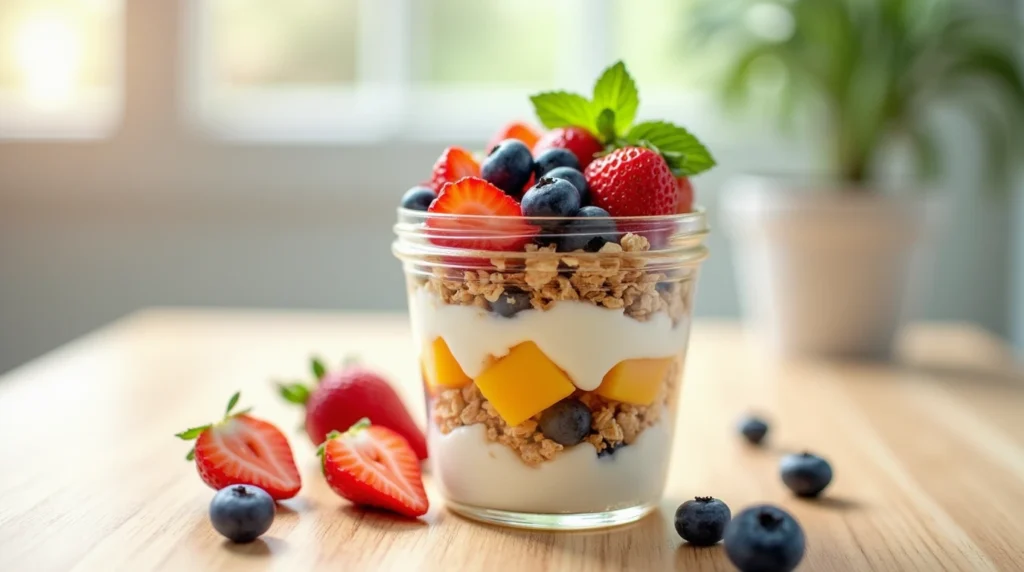If you’re looking for a way to indulge in a sweet treat without the guilt, cottage cheese desserts might be just what you need. Packed with protein and lower in fat compared to other ingredients, cottage cheese adds a creamy texture and rich flavor to a variety of sweet dishes. Whether you’re craving a no-bake cheesecake, a refreshing parfait, or a decadent chocolate mousse, cottage cheese can be the star of your dessert. In this post, we’ll explore some simple and delicious cottage cheese dessert recipes that are not only healthy but also satisfying for your sweet tooth. Let’s dive in!
Table of Contents
Why Cottage Cheese Is Perfect for Desserts
Health Benefits of Cottage Cheese in Desserts
Cottage cheese isn’t just for savory dishes—it also brings some amazing health benefits to your sweet treats. If you’re trying to make healthier choices without sacrificing flavor, cottage cheese is an excellent option to include in your desserts. Here’s why:
- High in Protein
One of the standout benefits of cottage cheese is its high protein content. Unlike many traditional dessert ingredients, cottage cheese is packed with protein, which helps keep you fuller for longer. This makes it a great addition to your desserts if you’re looking for something that satisfies your sweet cravings without causing a sugar crash later. Protein also supports muscle repair and growth, so it’s a nutritious choice for anyone with an active lifestyle. - Low in Fat and Calories
Cottage cheese is relatively low in fat compared to other dairy products like cream cheese or heavy cream, making it a healthier option for indulgent desserts. By swapping out high-fat ingredients with cottage cheese, you can significantly reduce the overall calorie content of your dessert without losing any of the creaminess or texture. It’s a win-win for those who want to enjoy a sweet treat without overloading on calories. - Rich in Calcium
Calcium is essential for strong bones and teeth, and cottage cheese is a great source of this important mineral. Adding cottage cheese to your desserts can help support your bone health while also satisfying your sweet tooth. Plus, it can help balance your diet, especially if you don’t consume enough other calcium-rich foods. - Supports Digestive Health
Cottage cheese contains probiotics, which are beneficial bacteria that promote gut health. Probiotics help with digestion, improve gut flora, and can even enhance your immune system. So not only are you enjoying a delicious dessert, but you’re also helping your digestive system stay in good shape.

Cottage Cheese vs. Other Dairy Ingredients
When it comes to making desserts, dairy products like cream cheese, Greek yogurt, and ricotta cheese are often used to create that rich, creamy texture we love. But have you ever considered using cottage cheese instead? While it might not be the first ingredient that comes to mind, cottage cheese offers some unique advantages when compared to other popular dairy options. Let’s take a closer look at how it stacks up:
- Cottage Cheese vs. Cream Cheese
Cream cheese is often a go-to for cheesecakes and frostings because of its smooth, velvety texture. However, cream cheese is also high in fat and calories, which can add up quickly in a dessert. Cottage cheese, on the other hand, is lower in fat and calories, making it a lighter option. While it has a slightly different texture, blending cottage cheese in your dessert recipes (especially if you use a food processor) can create a creamy, smooth consistency that’s almost as rich as cream cheese, but with a healthier twist. - Cottage Cheese vs. Greek Yogurt
Greek yogurt is another popular ingredient used in desserts for its thick texture and tangy flavor. It’s also packed with protein and probiotics, much like cottage cheese. However, Greek yogurt can sometimes have a stronger tartness that doesn’t always work in sweeter recipes. Cottage cheese has a much milder flavor and a more delicate, creamy taste, making it a better option if you want to keep the focus on sweetness without an overpowering tang. Plus, cottage cheese is often lower in sugar than flavored Greek yogurt, giving you more control over the sweetness of your dessert. - Cottage Cheese vs. Ricotta Cheese
Ricotta cheese is commonly used in desserts like cannoli and cheesecake for its smooth texture and mild flavor. While ricotta is a great option, cottage cheese has a similar texture but is typically lower in fat and calories. Ricotta tends to be a bit creamier, but cottage cheese is still a great alternative if you’re looking for a healthier substitute. With a little blending, cottage cheese can take on a similar consistency, and its slightly firmer texture can even add an interesting bite to your desserts. - Cottage Cheese’s Unique Advantage
What truly sets cottage cheese apart from other dairy ingredients is its high protein content. Cottage cheese is packed with protein, which helps create a more satisfying, filling dessert. This makes it an excellent choice for anyone looking to keep their sugar intake in check or for those who need a more substantial treat. It’s also a great option if you’re trying to increase your protein intake without turning to processed snacks or shakes.
Customization for Different Diets
One of the best things about cottage cheese is how easily it can be adapted to fit a variety of dietary preferences. Whether you’re following a specific eating plan, have food sensitivities, or just want to make a healthier version of your favorite dessert, cottage cheese can be a great base. Let’s explore how you can customize cottage cheese desserts for different diets:
- Gluten-Free Desserts
Many desserts rely on flour or other gluten-containing ingredients for their texture, but that’s not a problem with cottage cheese. Since cottage cheese is naturally gluten-free, you can make a wide range of desserts that are safe for those with gluten sensitivities or celiac disease. For example, if you’re making a cheesecake with cottage cheese, you can easily substitute a gluten-free crust made from almond flour or gluten-free graham crackers. This way, you get all the deliciousness of a traditional dessert without any gluten! - Low-Carb and Keto-Friendly Options
For those following a low-carb or keto diet, traditional sugary desserts can quickly throw you out of ketosis. The good news is that cottage cheese can still be part of a keto-friendly dessert! With only a few carbs per serving, it’s a great choice for low-carb treats. By using sugar substitutes like stevia or erythritol instead of regular sugar, you can create a dessert that feels indulgent without spiking your carb intake. A keto-friendly cottage cheese mousse or cheesecake with a nut-based crust can be just as rich and satisfying as its higher-carb counterparts. - Dairy-Free Alternatives
If you’re following a dairy-free diet, whether due to lactose intolerance, a vegan lifestyle, or any other reason, it might seem like dairy-based desserts are off the table. But you don’t have to miss out on the creamy texture cottage cheese brings to desserts. You can easily make dairy-free versions by swapping cottage cheese for plant-based alternatives like cashew cream, coconut yogurt, or almond-based cream cheese. These alternatives will still provide a smooth, rich texture, and they can be sweetened and flavored in the same way as cottage cheese desserts. - Lower-Sugar and Diabetic-Friendly Options
Cottage cheese is naturally low in sugar, which makes it an excellent choice for those trying to reduce their sugar intake, especially individuals managing diabetes. Instead of using refined sugar, you can sweeten your cottage cheese desserts with natural alternatives like stevia, monk fruit, or a drizzle of honey (in moderation). This way, you can still enjoy a delicious dessert without worrying about blood sugar spikes. A cottage cheese and berry parfait, for example, can be both low-sugar and rich in antioxidants, making it a perfect choice for those watching their sugar levels. - High-Protein Snacks for Fitness Enthusiasts
If you’re into fitness or trying to maintain a balanced diet with a focus on protein, cottage cheese is an ideal dessert ingredient. Its high protein content helps with muscle recovery and keeps you feeling full longer. You can easily boost the protein in your desserts by adding ingredients like chia seeds, hemp seeds, or protein powder. For instance, a high-protein cottage cheese pudding made with vanilla protein powder can be a satisfying post-workout treat that helps you meet your nutritional goals while satisfying your sweet tooth.
3 Easy and Delicious Cottage Cheese Dessert Recipes
Cottage Cheese Cheesecake

Cheesecake is one of those classic desserts that always seems to impress, but it’s often associated with being heavy and high in calories. If you’re craving cheesecake but want a lighter, healthier version, cottage cheese cheesecake is the perfect solution. Thanks to the creamy texture and mild flavor of cottage cheese, you can create a delicious cheesecake that’s not only satisfying but also lower in fat and calories. Let’s dive into how you can make a simple, tasty cottage cheese cheesecake!
- The Creamy Texture
One of the key elements of a great cheesecake is its creamy, smooth texture, and cottage cheese delivers just that. By blending cottage cheese, you can achieve a silky consistency that mimics the richness of cream cheese without all the extra fat. The texture of cottage cheese might be a little different from traditional cheesecake fillings, but once it’s blended, it becomes incredibly smooth and velvety, making for a delightful dessert. - How to Make Cottage Cheese Cheesecake
Making cottage cheese cheesecake is surprisingly easy, and you don’t even need to bake it! Here’s a simple method to get you started:- Ingredients:
- 2 cups of cottage cheese (preferably low-fat or fat-free for a lighter option)
- 1/2 cup of Greek yogurt or sour cream (adds extra creaminess)
- 1/4 cup of honey or maple syrup (for natural sweetness)
- 1 teaspoon of vanilla extract (for added flavor)
- 1/2 cup of a nut-based crust (like almond flour or crushed almonds mixed with butter)
- A pinch of salt (to balance the sweetness)
- Directions:
- Prepare the crust: If you’re making a crust, simply mix almond flour or crushed almonds with melted butter, and press the mixture into the bottom of a springform pan. This creates a simple, gluten-free base for your cheesecake.
- Blend the filling: In a food processor or blender, blend the cottage cheese, Greek yogurt (or sour cream), honey or maple syrup, and vanilla extract until smooth and creamy. You can adjust the sweetness to your liking by adding more honey or syrup.
- Assemble: Pour the creamy cottage cheese mixture into the prepared crust and smooth the top with a spatula.
- Chill: Since this is a no-bake version, place the cheesecake in the refrigerator for at least 4-6 hours, or overnight, to set. This allows the flavors to meld together and the cheesecake to firm up.
- Serve and enjoy: Once set, remove from the pan, and top with fresh fruit like berries or a drizzle of fruit sauce for extra flavor. You can even sprinkle a little cinnamon or cocoa powder on top for a different twist.
- Ingredients:
- Customizing Your Cottage Cheese Cheesecake
One of the best things about cottage cheese cheesecake is how easy it is to customize to your taste preferences. Here are a few ways to make this dessert even more exciting:- Fruit toppings: Fresh berries, sliced mango, or a homemade fruit compote can add a burst of flavor and color to your cheesecake. You can also add citrus zest, like lemon or lime, to the filling for a fresh, zesty kick.
- Add-ins: For a little extra texture, consider folding in chopped nuts like almonds or pecans, or even a handful of dark chocolate chips for a more indulgent treat.
- Sweeteners: If you’re looking to make this dessert lower in sugar, try using a sugar substitute like stevia, monk fruit, or erythritol. These sweeteners can provide the same sweetness without adding extra calories or affecting your blood sugar.
- Flavor variations: You can easily change the flavor of your cheesecake by experimenting with different extracts. Try almond extract for a nutty twist, or even cinnamon for a warm, cozy flavor.
- Why Cottage Cheese is the Perfect Choice for Cheesecake
Cottage cheese works incredibly well in cheesecake because it’s not as dense or overly rich as cream cheese, making the dessert lighter and more refreshing. The mild flavor of cottage cheese lets the natural sweetness of your toppings and sweeteners shine through. Plus, with its high protein content, you can enjoy a guilt-free treat that’s both satisfying and nutritious. It’s the perfect balance of indulgence and health!
Cottage Cheese and Fruit Parfait

If you’re craving something refreshing, light, and satisfying, Cottage Cheese and Fruit Parfait is the perfect dessert (or even breakfast!) to whip up. This dessert combines the creamy richness of cottage cheese with the natural sweetness of fresh fruits, creating a treat that’s both indulgent and healthy. Plus, it’s incredibly easy to make and can be customized with your favorite fruits and toppings.
- The Beauty of a Parfait
What makes a parfait so special is the layering effect. It’s not just a dessert—it’s a visual treat! By layering cottage cheese with fresh fruits and perhaps a crunchy element like granola or nuts, you create a dessert that’s as beautiful as it is delicious. The best part is that parfaits are super versatile, allowing you to use whatever fruits are in season or whatever you have on hand. - How to Make Cottage Cheese and Fruit Parfait
Making this parfait is simple and only takes a few minutes to assemble. Here’s how to do it:- Ingredients:
- 1 cup of cottage cheese (full-fat, low-fat, or fat-free depending on your preference)
- 1-2 cups of fresh fruit (berries like strawberries, blueberries, and raspberries are great, but you can also use mango, peaches, or kiwi)
- 1/4 cup of granola (for crunch, but you can use nuts or seeds for a healthier, gluten-free option)
- 1 tablespoon of honey or maple syrup (optional, for added sweetness)
- A dash of vanilla extract (optional, for a subtle flavor boost)
- Directions:
- Prepare the cottage cheese: If you prefer a smoother texture, you can blend the cottage cheese briefly in a food processor or blender. Otherwise, you can simply use it as is for a thicker, chunkier texture. Sweeten it with a little honey or maple syrup to taste, and add a splash of vanilla extract if you like.
- Layer the parfait: In a glass or jar, start by spooning a layer of sweetened cottage cheese at the bottom. Then, add a layer of fresh fruit. Repeat this process until your glass is filled, finishing with a layer of fruit on top.
- Top it off: Sprinkle granola, nuts, or seeds on top for a delightful crunch. You can also drizzle a little extra honey over the top or add a sprinkle of cinnamon for extra flavor.
- Serve and enjoy: Once you’ve built your parfait, it’s ready to serve! For an even colder treat, you can chill it in the fridge for 30 minutes before serving, allowing the flavors to meld together.
- Ingredients:
- Customizing Your Cottage Cheese and Fruit Parfait
One of the best things about this dessert is how easily it can be customized to fit your personal taste or dietary needs. Here are a few ideas to make it your own:- Fruits: You can mix and match whatever fruits you like or have on hand. Berries are always a popular choice because of their natural sweetness and antioxidants, but you could also try tropical fruits like pineapple, mango, or papaya for a more exotic flavor. Citrus fruits like oranges or grapefruit can add a tangy twist that complements the creaminess of the cottage cheese perfectly.
- Sweeteners: If you’re looking to cut back on sugar, you can skip the honey or maple syrup, especially if your fruit is already naturally sweet. Alternatively, you can use a natural sweetener like stevia or monk fruit, which won’t raise your blood sugar but will still give your parfait that sweet taste.
- Crunch Factor: Granola is a popular choice for added crunch, but you can get creative with your toppings. Try using toasted coconut flakes, chopped almonds, walnuts, or even pumpkin seeds for a satisfying crunch that adds a bit of extra protein and healthy fats.
- Flavor Variations: Add a sprinkle of cinnamon, nutmeg, or even cocoa powder on top for a different flavor profile. If you want a richer flavor, a small spoonful of almond butter or peanut butter between the layers adds creaminess and depth.
- Health Benefits of Cottage Cheese and Fruit Parfait
Not only is this parfait a treat for your taste buds, but it’s also a nutritious snack or dessert. Cottage cheese provides a great source of protein, which helps keep you feeling full and satisfied longer. It’s also packed with calcium for strong bones, and by pairing it with fresh fruits, you’re adding vitamins, antioxidants, and fiber to your meal. The granola or nuts bring in healthy fats and crunch, making this parfait a well-rounded, nutrient-packed option. - A Perfect Dessert for Any Occasion
Whether you’re serving this parfait as a light breakfast, an afternoon snack, or a healthy dessert after dinner, it’s the perfect go-to option for any time of day. It’s easy to make ahead, so you can prepare it in advance for a quick grab-and-go meal. Plus, it’s easily scalable—whether you’re making one serving or a batch for guests, you can adjust the quantities accordingly.
Cottage Cheese Chocolate Mousse

If you’re a chocolate lover but want a dessert that’s a bit healthier than traditional chocolate mousse, Cottage Cheese Chocolate Mousse is the answer! This dessert takes the rich, creamy texture of classic mousse and lightens it up using cottage cheese. With the right ingredients, you can enjoy a delicious, velvety mousse that feels indulgent but is packed with protein and lower in fat. It’s perfect for anyone looking for a satisfying treat without the guilt.
- The Creamy, Decadent Texture
Traditional chocolate mousse is known for its smooth, airy texture, and cottage cheese can achieve something similar when blended properly. Cottage cheese has a naturally creamy texture, and when it’s blended until smooth, it mimics the lightness and richness that you’d expect in a mousse. The addition of cocoa powder and a touch of sweetener makes it taste just like the decadent chocolate mousse you love, but with the added benefits of protein and fewer calories. - How to Make Cottage Cheese Chocolate Mousse
Making this mousse is quick and easy, and you don’t even need any fancy equipment. Here’s a simple recipe to get you started:- Ingredients:
- 1 1/2 cups of cottage cheese (preferably low-fat or fat-free for a lighter option)
- 2 tablespoons of unsweetened cocoa powder (for that rich chocolate flavor)
- 2-3 tablespoons of honey or maple syrup (depending on how sweet you like it)
- 1 teaspoon of vanilla extract (for added flavor)
- 1/4 cup of milk (dairy or non-dairy, depending on your preference)
- A pinch of salt (to enhance the sweetness and balance the flavors)
- Optional: Whipped cream or shaved chocolate for topping
- Directions:
- Blend the cottage cheese: Place the cottage cheese in a blender or food processor. Blend it until it’s completely smooth and creamy. This may take a minute or two, but the smoother it is, the better the mousse texture will be.
- Add the cocoa powder and sweetener: Add the unsweetened cocoa powder, honey or maple syrup, vanilla extract, and a pinch of salt to the blender. Blend again until everything is well combined and smooth.
- Adjust the texture: If you find the mousse is too thick, add a little milk, one tablespoon at a time, to reach your desired consistency. You want it to be smooth and airy but not runny.
- Chill the mousse: Transfer the mousse to serving cups or bowls and refrigerate for at least 1-2 hours to allow it to firm up. The chilling process gives the mousse a light, airy texture and makes it even more refreshing.
- Serve and enjoy: Once chilled, you can top the mousse with a dollop of whipped cream, a sprinkle of shaved chocolate, or even a few fresh berries for added flavor and visual appeal.
- Ingredients:
- Customizing Your Cottage Cheese Chocolate Mousse
Just like any dessert, you can make this mousse your own by adding or changing ingredients to suit your tastes. Here are some ideas for customizing:- Sweeteners: If you’re trying to cut back on sugar, you can easily swap out honey or maple syrup for a natural sweetener like stevia, monk fruit, or erythritol. These alternatives will give you the sweetness you want without the added calories or sugar spikes.
- Flavors: Want to make it a bit fancier? Add a little instant coffee or espresso powder to enhance the chocolate flavor and give the mousse a subtle mocha twist. A pinch of cinnamon or even some chili powder can add an unexpected depth to the chocolate flavor, making it feel even more indulgent.
- Toppings: For an extra indulgent touch, you can top your mousse with whipped cream, a drizzle of melted dark chocolate, or chopped nuts like almonds or hazelnuts. You could even add a few chocolate shavings for an extra touch of elegance.
- Extra texture: If you like a little crunch, try folding in a handful of crushed cookies, granola, or even toasted coconut flakes just before chilling the mousse. This will give the dessert a pleasant contrast between creamy and crunchy textures.
- Health Benefits of Cottage Cheese in Chocolate Mousse
While traditional chocolate mousse can be quite rich in fat and calories, using cottage cheese in this recipe gives you the benefit of high protein while keeping the dessert lighter. Cottage cheese is also rich in calcium and low in fat (especially if you use a lower-fat version), making this mousse a healthier alternative. The addition of cocoa powder provides antioxidants, and using a natural sweetener like honey or maple syrup adds a touch of sweetness without going overboard on sugar. This dessert feels indulgent, but it’s a much better option for anyone looking to treat themselves without overdoing it. - Why Cottage Cheese Chocolate Mousse is a Perfect Treat
This mousse is not only quick and easy to make but also versatile enough for various occasions. It works as an after-dinner treat, a special dessert for a party, or even a satisfying snack. It’s great for anyone following a high-protein or low-calorie diet, and it’s a fantastic way to indulge in chocolate without going off-track from your health goals.
Conclusion
Cottage cheese desserts are an incredible way to indulge in sweet treats while staying mindful of your health and nutrition. Whether you’re making a cottage cheese cheesecake, a fruit parfait, or a rich chocolate mousse, cottage cheese offers a creamy, high-protein alternative to traditional dessert ingredients. This humble dairy product adds texture, richness, and nutritional benefits to your favorite sweets without compromising on flavor.
Throughout this post, we’ve seen how versatile cottage cheese can be in creating healthier versions of classic desserts. Its ability to blend smoothly and absorb different flavors makes it perfect for a variety of recipes. Whether you’re looking to reduce fat, add more protein, or simply make a lighter dessert, cottage cheese is a fantastic option. Plus, it’s easy to customize to fit different dietary needs, such as gluten-free, keto, or dairy-free diets. You can make these desserts your own by choosing your favorite fruits, sweeteners, and toppings, creating a treat that’s uniquely tailored to you.
So, the next time you’re craving something sweet, don’t overlook the power of cottage cheese. It’s a simple yet incredibly effective way to enjoy delicious desserts that are satisfying and better for your body. By swapping out heavier ingredients for cottage cheese, you’re not only making a healthier choice but also embracing a world of creative, guilt-free desserts that everyone can enjoy. Whether it’s for a special occasion, a snack, or just a way to end your day on a sweet note, cottage cheese desserts are the perfect go-to option. Enjoy experimenting with these recipes and treat yourself to the lighter, healthier side of dessert!

